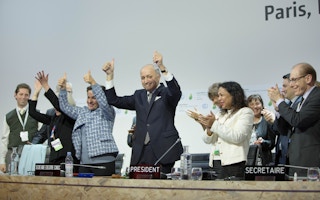The historic Paris Agreement adopted in December 2015 by nearly 200 nations is the first universal climate change agreement that will bind both developing and developed countries to their commitments to slash their greenhouse gas emissions. It is the culmination of many years of negotiations under the United Nations Framework Convention on Climate Change or UNFCCC.
To continue reading, subscribe to Eco‑Business.
There's something for everyone. We offer a range of subscription plans.
- Access our stories and receive our Insights Weekly newsletter with the free EB Member plan.
- Unlock unlimited access to our content and archive with EB Circle.
- Publish your content with EB Premium.
The agreement provides a framework that allows nations to submit pledges, also known as “nationally determined contributions”, over recurring cycles. At present, more than 180 nations have submitted their pledges – this is an unprecedented achievement and an important first step in the global effort to limit the consequences of global warming.
Significantly, the agreement also includes a 2°C temperature goal, a level scientists say is required to avert dangerous climate change, and calls on nations to pursue efforts to limit the temperature increase to 1.5°C above pre-industrial levels.
Singapore, for its part, aims to reduce its greenhouse gas emissions per GDP dollar by 36 per cent from 2005 levels by 2030, and to stabilise its emissions with the aim of peaking by then.
What’s next for Singapore?
What exactly will the Paris Agreement mean for us in Singapore? Fundamentally, it will mean a change in our way of life.
As Minister for Foreign Affairs Dr Vivian Balakrishnan said to reporters just hours after the Paris Agreement was adopted at the UN summit, “It’s about our way of life and the choices we make for our consumption.”
These choices include reducing energy use by being more energy efficient; constructing more green buildings; promoting public transport and harnessing more clean energy such as solar.
However, this will “not be easy for us” considering that Singapore has limited alternative energy options and we will need to balance economic growth with reducing emissions.
Minister for the Environment and Water Resources Masagos Zukifli has said that Singapore’s pledge is a “very huge commitment … (and) it requires the whole of government as well as the economy to realign, to look at ways to bring down our business-as-usual emissions.”
The path ahead is fraught with challenges; these revolve mainly around changing mindsets and overcoming technological hurdles. Nonetheless, there are also opportunities to develop new technologies and green initiatives.
Changing mindsets and behaviour
A large chunk of the reductions has to come from businesses, as they are the biggest consumers of energy in the country.
In this respect, the Paris Agreement provides the certainty needed for businesses to go low-carbon. It sends a signal to industry globally that it will have to raise energy efficiency.
While there are already a slew of regulations and programmes in Singapore to encourage industry to be more energy efficient, the next challenge is to convince more companies to take action.
Many small and medium businesses, especially those surviving on razor-thin margins, often say they cannot afford to replace inefficient appliances, lighting as well as cooling systems.
A combination of ‘sticks and carrots’ will be needed to nudge more companies into retrofitting their systems. Growth and environmentalism do not have to be mutually exclusive.
Singapore is, encouragingly, making headway with greening its building stock. From only 17 buildings in 2005, the number of green buildings has grown to more than 2,500, making up around 30 per cent of all buildings.
By 2030, Singapore aims for 80 per cent of schools, offices, homes and public venues to be green.
Beyond raising energy efficiency, building owners will also need to engage their tenants to be mindful with their own energy usage and to reduce their environmental footprint – as a building is only as green as its occupiers.
Consumers are key, too
In homes, new technologies such as the home energy management systems (HEMS) that have been installed under a pilot programme in Punggol could help households reduce their power consumption. Each system comes with a smartphone application that allows the household to see how much electricity is being consumed in real-time or control air-conditioners, even when the occupants are not at home. Such solutions are progressively being installed across housing estates by the Housing & Development Board.
However, users will still need to make an effort to consciously monitor their energy usage and adjust accordingly. Getting residents used to this way of life will take time and effort, as forming habits is not easy.
This change in mindset and behavior must also be extended to commuters. Currently, Singapore’s population of almost 600,000 cars account for 35 per cent of transport emissions produced, and more must be done to reduce both the number of trips taken by private vehicles and their emissions.
Simply by choosing public transport such as buses and the MRT, or even cycling and walking, we can contribute in a tangible way. Schemes such as car-free Sundays or car-free zones, and car-sharing schemes, will also help.
To make a dent in our transport emissions, electric vehicles will also play a big role. Singapore is already embarking on a series of EV trials on the roads, with the aim to increase the EV population in the country and boost related infrastructure.
Other than electric vehicles, Singapore is promoting the use of more energy efficient vehicles through the incentive programme, the Carbon Emissions-based Vehicle Scheme (CEVS), to encourage motorists to buy hybrids such as Toyota’s Prius and Camry Hybrid, Honda’s Insight, and Mercedes-Benz’s E300.
However, changing behavior (convincing car-owners to use their vehicles less) and mindsets (car ownership as a status symbol) may be among the toughest nuts to crack.
Technological, logistical hurdles
Recycling will be another key strategy in reducing our environmental impact. In 2014, the recycling rate of all waste collected – such as construction debris, paper, food and plastic – was 60 per cent. The domestic recycling rate, that is, recycling of waste produced in households, was only 19 per cent. The government wants to increase this to 30 per cent by 2030.
The government also aims to increase the recycling rate for food waste from the current 13 per cent. It has started with a pilot food waste collection system at several hawker centres to convert the waste into compost.
Curbing the growing volume of wood waste would require changing our behaviour, as well as the way our waste is collected.
Households and food & beverage outlets will have to conscientiously sort out the different types of trash they generate, and municipals will need to change the way they collect waste. It is a behavioural as well as logistical challenge.
Finally, Singapore will tap on more solar energy. Already, commercial building owners are increasingly installing photovoltaic panels on their rooftops to meet their energy needs – at a cost lower than conventional energy.
Solar deployment in Singapore will be increased from the current 47MWp, to provide around 350MWp of electricity by 2020. Government agencies have come together to aggregate their demand for solar energy, which will help spur the growth of the solar industry in Singapore.
In this vein, HDB has recently awarded its largest solar leasing project to Sunseap, covering over 800 HDB blocks as well as sites under the Ministry of Home Affairs and PUB.
Taking adoption to the next level, however, will involve improving storage technologies such as batteries and integrating solar power into the country’s energy grid better. These efforts will require time, money and research & development.
Singapore’s targets for the Paris agreement are aggressive and ambitious, as Minister Masagos has said. The challenge would be balancing economic growth that can still support livelihoods with reducing carbon emissions.
As citizens, we must adopt habits such as opting for public transport, using energy-efficient appliances and lighting, and reducing and recycling our waste. These steps do require effort but collectively will make a significant difference in our country’s carbon footprint.
This article was first published on the NCCS website. Subscribe to their newsletter here or follow them on their Facebook page.











